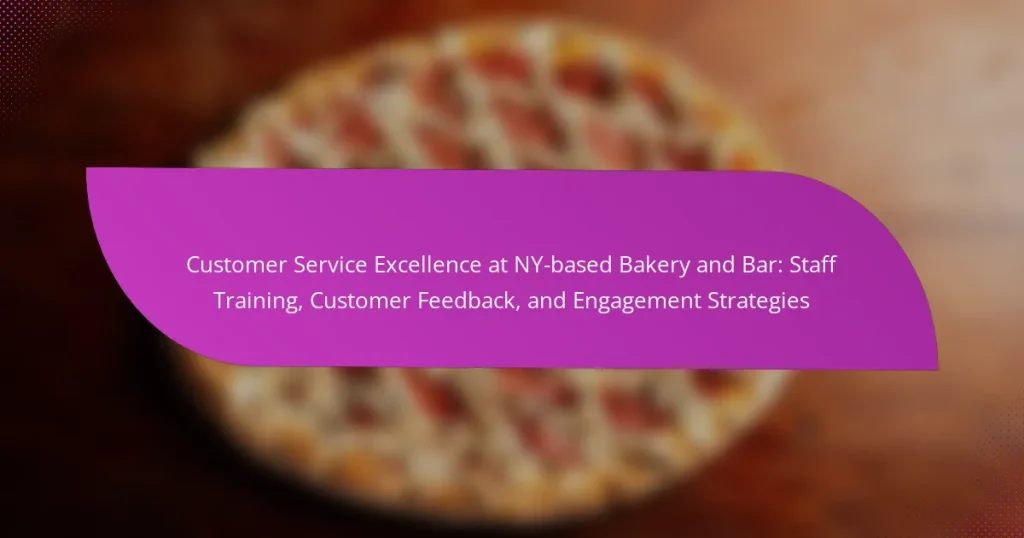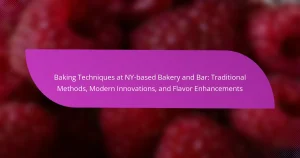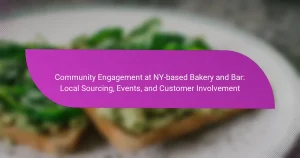Customer Service Excellence at a NY-based Bakery and Bar is achieved through a combination of attentive staff, efficient service, and a welcoming atmosphere. Staff training emphasizes product knowledge and effective communication to meet customer needs, while gathering customer feedback is crucial for continuous improvement. Engagement strategies, such as personalized service, loyalty programs, and interactive events, further enhance the customer experience and foster long-term relationships. By implementing these practices, the bakery and bar builds trust, boosts customer satisfaction, and encourages repeat business.
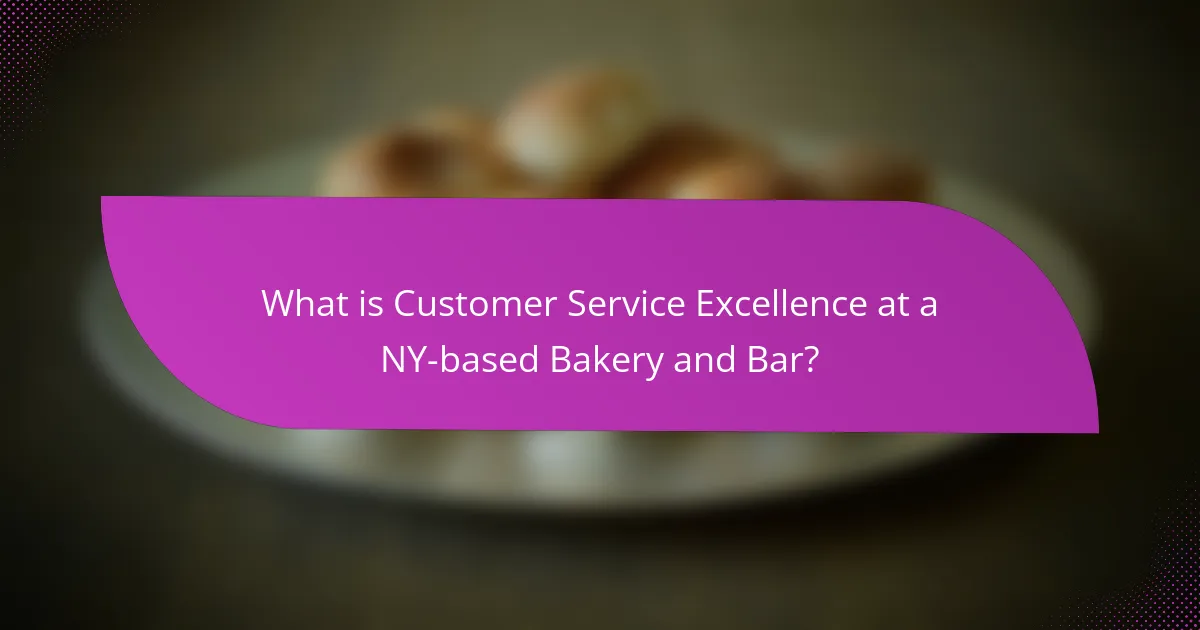
What is Customer Service Excellence at a NY-based Bakery and Bar?
Customer Service Excellence at a NY-based Bakery and Bar involves delivering outstanding service to customers consistently. This includes attentive staff, quick service, and a welcoming atmosphere. Staff training focuses on product knowledge and customer interaction skills. Effective communication is essential for understanding customer needs. Gathering customer feedback helps improve service quality. Engaging customers through loyalty programs enhances their experience. A commitment to quality and consistency builds customer trust. These practices contribute to a positive reputation and repeat business.
How is customer service defined in the context of a bakery and bar?
Customer service in the context of a bakery and bar is defined as the assistance and support provided to customers before, during, and after their purchase. This includes greeting customers, taking orders, and addressing inquiries about menu items. Effective customer service ensures a positive dining experience, fostering customer loyalty. According to a survey by the National Restaurant Association, 75% of customers consider service quality as a key factor in their dining choices. Additionally, prompt service and friendly interactions enhance overall satisfaction, leading to repeat business and positive reviews.
What are the key elements that contribute to customer service excellence?
Key elements that contribute to customer service excellence include effective communication, responsiveness, and empathy. Effective communication ensures clear understanding between staff and customers. Responsiveness involves timely reactions to customer inquiries and issues. Empathy allows staff to connect with customers on a personal level. Training staff in these areas is crucial. Research indicates that businesses with strong customer service training see up to a 50% increase in customer satisfaction. Engaging with customer feedback further enhances service quality. Implementing strategies based on feedback can lead to continuous improvement. Overall, these elements create a positive customer experience.
Why is customer service important for a bakery and bar?
Customer service is crucial for a bakery and bar as it directly impacts customer satisfaction and loyalty. Positive interactions encourage repeat business and word-of-mouth referrals. In the food and beverage industry, customer experience can significantly influence sales. According to a study by the American Express, 70% of consumers are willing to spend more with a company that provides excellent customer service. Additionally, friendly and attentive service can enhance the overall dining experience, making customers more likely to return. In a competitive market, exceptional customer service sets a bakery and bar apart from others. It fosters a welcoming atmosphere, encouraging customers to enjoy their time and recommend the establishment to others.
What role does staff training play in achieving customer service excellence?
Staff training is essential for achieving customer service excellence. It equips employees with the necessary skills and knowledge to meet customer needs effectively. Trained staff can provide accurate product information and handle inquiries efficiently. This leads to improved customer satisfaction and loyalty. Studies show that organizations with comprehensive training programs see a 24% increase in customer satisfaction scores. Additionally, well-trained employees are more confident in their roles, which enhances their interaction with customers. This confidence translates into a positive customer experience. Overall, effective staff training directly correlates with enhanced service quality and customer retention.
How can effective training programs enhance staff performance?
Effective training programs enhance staff performance by equipping employees with necessary skills and knowledge. They lead to improved job competency and confidence. Staff trained effectively can handle customer inquiries more efficiently. This results in higher customer satisfaction rates. According to a study by the Association for Talent Development, companies that invest in employee training see a 24% increase in profit. Furthermore, well-trained staff exhibit better teamwork and communication. This fosters a positive work environment. Consequently, effective training directly correlates with enhanced overall performance in customer service settings.
What specific skills should be included in staff training for customer service?
Effective customer service training should include communication skills, problem-solving abilities, and empathy. Communication skills enable staff to convey information clearly and listen actively. Problem-solving abilities help staff address customer issues efficiently. Empathy allows staff to connect with customers on a personal level. Additionally, training should cover product knowledge to assist customers accurately. Time management skills are essential for handling multiple tasks. Conflict resolution techniques prepare staff for challenging interactions. Finally, training in teamwork fosters a collaborative environment. These skills collectively enhance customer satisfaction and loyalty.
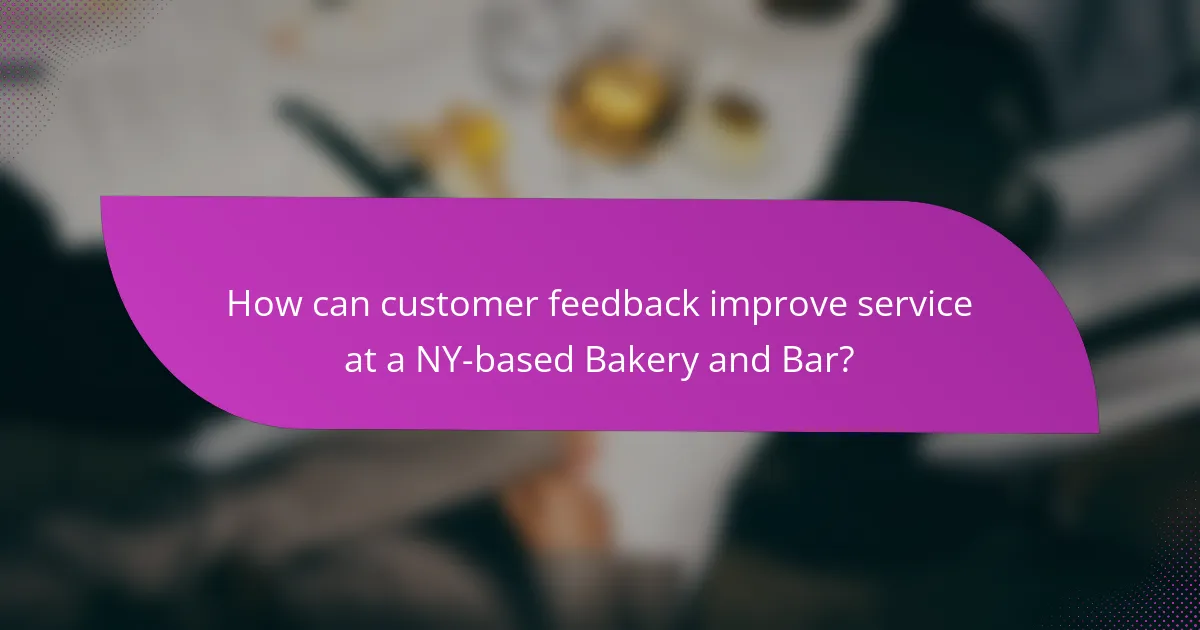
How can customer feedback improve service at a NY-based Bakery and Bar?
Customer feedback can significantly enhance service at a NY-based Bakery and Bar. It provides insights into customer preferences and experiences. By analyzing feedback, management can identify areas needing improvement. For instance, if customers consistently mention slow service, the bakery can adjust staffing or streamline processes. Positive feedback highlights successful practices that can be expanded. Implementing changes based on feedback can increase customer satisfaction and loyalty. Studies show that businesses responsive to feedback see up to a 10% increase in repeat customers. Regularly soliciting feedback fosters a culture of continuous improvement.
Why is customer feedback vital for service improvement?
Customer feedback is vital for service improvement because it provides direct insights into customer experiences. Understanding these experiences helps businesses identify strengths and weaknesses in their services. Feedback allows businesses to tailor their offerings to meet customer needs more effectively. Studies show that companies that actively seek customer feedback can improve customer satisfaction by up to 20%. Additionally, customer feedback fosters a culture of continuous improvement within an organization. This approach enables businesses to adapt quickly to changing market demands. Ultimately, leveraging customer feedback leads to enhanced loyalty and increased revenue.
What methods can be used to gather customer feedback effectively?
Surveys and questionnaires are effective methods to gather customer feedback. They can be distributed online or in-person. Surveys allow customers to provide structured responses. This method can yield quantitative data for analysis. Focus groups gather qualitative insights from diverse customers. They encourage open discussion about experiences. Customer interviews provide in-depth understanding of individual perspectives. This method can uncover specific issues or suggestions. Feedback forms at the point of sale capture immediate reactions. This approach can lead to timely improvements. Social media platforms also serve as feedback channels. They allow customers to share opinions publicly. Monitoring reviews on platforms like Yelp provides additional insights. Each method contributes to a comprehensive understanding of customer satisfaction.
How should feedback be analyzed to drive service enhancements?
Feedback should be analyzed through systematic categorization and trend identification. Start by collecting feedback from various sources, such as surveys, social media, and direct customer interactions. Next, categorize this feedback into themes, like service speed, product quality, and customer satisfaction. Analyze the frequency of each theme to identify patterns and prioritize areas needing enhancement. For example, if 70% of customers mention slow service, this becomes a focal point for improvement. Utilize quantitative metrics, such as Net Promoter Score (NPS) and Customer Satisfaction Score (CSAT), to measure feedback impact. Regularly review and adjust strategies based on ongoing feedback analysis to ensure continuous service improvement.
What are the best practices for responding to customer feedback?
Best practices for responding to customer feedback include acknowledging the feedback promptly. Timely responses show customers that their opinions are valued. Personalizing responses is crucial; addressing customers by name can enhance engagement. Providing solutions or corrective actions demonstrates commitment to improvement. Expressing gratitude for feedback fosters a positive relationship. Following up after resolving an issue can enhance customer satisfaction. Monitoring feedback trends can inform business decisions. According to a survey by Microsoft, 77% of customers view brands more favorably if they seek out and apply customer feedback.
How can positive feedback be leveraged to boost staff morale?
Positive feedback can significantly boost staff morale by enhancing job satisfaction and motivation. When employees receive recognition for their efforts, they feel valued and appreciated. This appreciation fosters a positive work environment. Research shows that employees who receive regular positive feedback are more engaged and productive. According to a Gallup study, organizations that implement recognition programs see a 14% increase in employee performance. By consistently providing positive feedback, management can create a culture of encouragement. This culture leads to improved team collaboration and overall morale.
What strategies can be implemented to address negative feedback constructively?
Implementing strategies to address negative feedback constructively involves active listening, empathy, and actionable responses. Active listening ensures that the customer’s concerns are fully understood. This can be achieved by repeating back what the customer has said to confirm understanding. Empathy helps to acknowledge the customer’s feelings, showing that their experience matters. Staff can express understanding by saying phrases like, “I can see why you feel that way.”
Actionable responses involve providing solutions or alternatives to the issue raised. For example, if a customer is unhappy with a product, offering a replacement or refund can demonstrate commitment to customer satisfaction. Training staff on these strategies can lead to improved customer relations and loyalty. Research indicates that businesses that effectively handle complaints can increase customer retention by up to 70%.
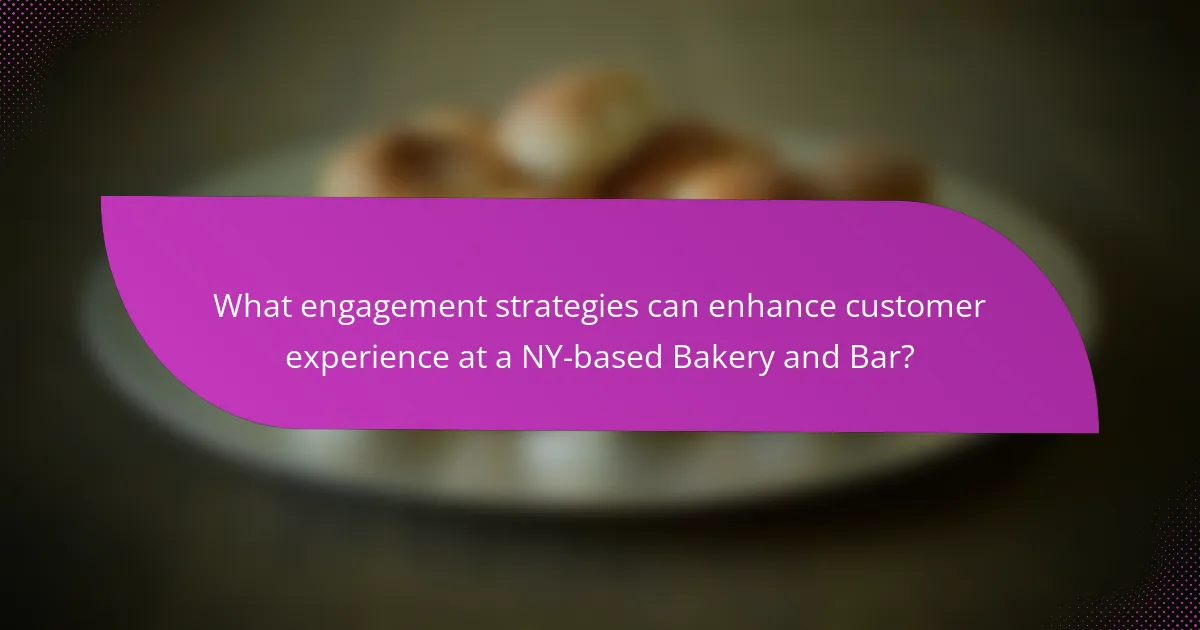
What engagement strategies can enhance customer experience at a NY-based Bakery and Bar?
Engagement strategies that can enhance customer experience at a NY-based Bakery and Bar include personalized service, loyalty programs, and interactive events. Personalized service involves staff remembering customer preferences and names, creating a welcoming atmosphere. Loyalty programs incentivize repeat visits by offering discounts or rewards, which can increase customer retention. Interactive events, such as baking classes or themed nights, foster community engagement and enhance the overall experience. According to a study by the National Restaurant Association, 70% of customers are more likely to return to a restaurant that offers engaging experiences. These strategies not only improve customer satisfaction but also build long-term relationships.
How can social media be utilized for customer engagement?
Social media can be utilized for customer engagement by fostering direct communication between the business and its customers. This platform allows for real-time interaction, enabling customers to ask questions and receive immediate responses. Engaging content, such as polls and giveaways, can encourage participation and feedback. Social media analytics can track customer preferences and behaviors, informing future strategies. According to a survey by Sprout Social, 64% of consumers want brands to connect with them on social media. This highlights the importance of active engagement in building customer loyalty.
What types of content resonate most with bakery and bar customers?
Bakery and bar customers resonate most with visual content, recipes, and promotions. Visual content, such as high-quality images of baked goods and drinks, attracts attention. Recipes that showcase unique offerings encourage customer engagement. Promotions, including discounts and special events, drive foot traffic. Engaging storytelling about the bakery’s history or sourcing ingredients builds a connection. User-generated content, like customer reviews and photos, enhances credibility. Seasonal content tied to holidays or local events keeps the offerings fresh. Additionally, behind-the-scenes videos of the baking process foster transparency and authenticity.
How can online interactions translate to in-store experiences?
Online interactions can translate to in-store experiences by creating a seamless customer journey. This involves integrating online engagement tools, such as social media and email marketing, with in-store promotions. For example, customers who receive personalized offers online can redeem them in-store. Additionally, online reviews can inform staff training and improve service quality. Research shows that 70% of consumers prefer brands that provide a consistent experience across channels. By leveraging online feedback, businesses can enhance in-store customer service. This approach fosters customer loyalty and encourages repeat visits.
What loyalty programs can be effective in retaining customers?
Effective loyalty programs for retaining customers include point-based systems, tiered rewards, and subscription models. Point-based systems reward customers with points for each purchase, encouraging repeat business. Tiered rewards offer increasing benefits based on customer spending levels, fostering loyalty through exclusive perks. Subscription models provide customers with regular discounts or products for a monthly fee, ensuring consistent engagement. Research shows that businesses with loyalty programs can see a 5-10% increase in customer retention rates. Additionally, 70% of consumers are more likely to recommend a brand with a good loyalty program.
What elements make a loyalty program appealing to customers?
An appealing loyalty program for customers includes rewards, exclusivity, and ease of use. Rewards should be valuable and attainable, encouraging repeat purchases. Exclusive offers create a sense of belonging and appreciation among loyal customers. Programs must be easy to understand and participate in, minimizing barriers to engagement. Transparency about how rewards are earned enhances trust. Personalization of rewards based on customer preferences increases relevance. Regular communication about program benefits keeps customers informed and engaged. Research shows that 70% of consumers are more likely to recommend a brand with a good loyalty program.
How can technology enhance loyalty program effectiveness?
Technology can enhance loyalty program effectiveness through data analytics and personalized communication. By utilizing data analytics, businesses can track customer behavior and preferences. This allows for targeted promotions that resonate with individual customers. Personalized communication fosters a stronger connection between the brand and its customers. For instance, sending tailored offers based on past purchases increases engagement.
Moreover, mobile apps streamline the loyalty experience. Customers can easily access their rewards and track points in real-time. This convenience encourages more frequent visits and purchases. Automation tools can also manage customer interactions efficiently. Automated reminders for rewards or special offers keep the program top of mind.
Statistics support these claims. According to a study by Bond Brand Loyalty, 79% of consumers are more likely to engage with a loyalty program that offers personalized experiences. Therefore, integrating technology not only enhances engagement but also drives customer retention.
What are some practical tips for ensuring customer service excellence?
To ensure customer service excellence, prioritize staff training and engagement. Regular training sessions enhance employee skills and knowledge. Empower staff to make decisions that benefit customers. Encourage active listening to understand customer needs. Implement a feedback system to gather insights from customers. Use this feedback to make improvements consistently. Recognize and reward exceptional customer service among staff. This motivates employees and fosters a positive environment. Statistics show that businesses with engaged employees outperform their competitors by 147% in earnings per share.
Customer Service Excellence at a NY-based Bakery and Bar focuses on delivering high-quality service through attentive staff, effective communication, and continuous improvement driven by customer feedback. Key elements include comprehensive staff training in communication, problem-solving, and empathy, which enhance customer satisfaction and loyalty. The article also explores the importance of engaging customers through loyalty programs and interactive events, as well as leveraging technology for effective feedback collection and analysis. Overall, these strategies contribute to a positive customer experience, fostering repeat business and a strong reputation in the competitive food and beverage industry.
